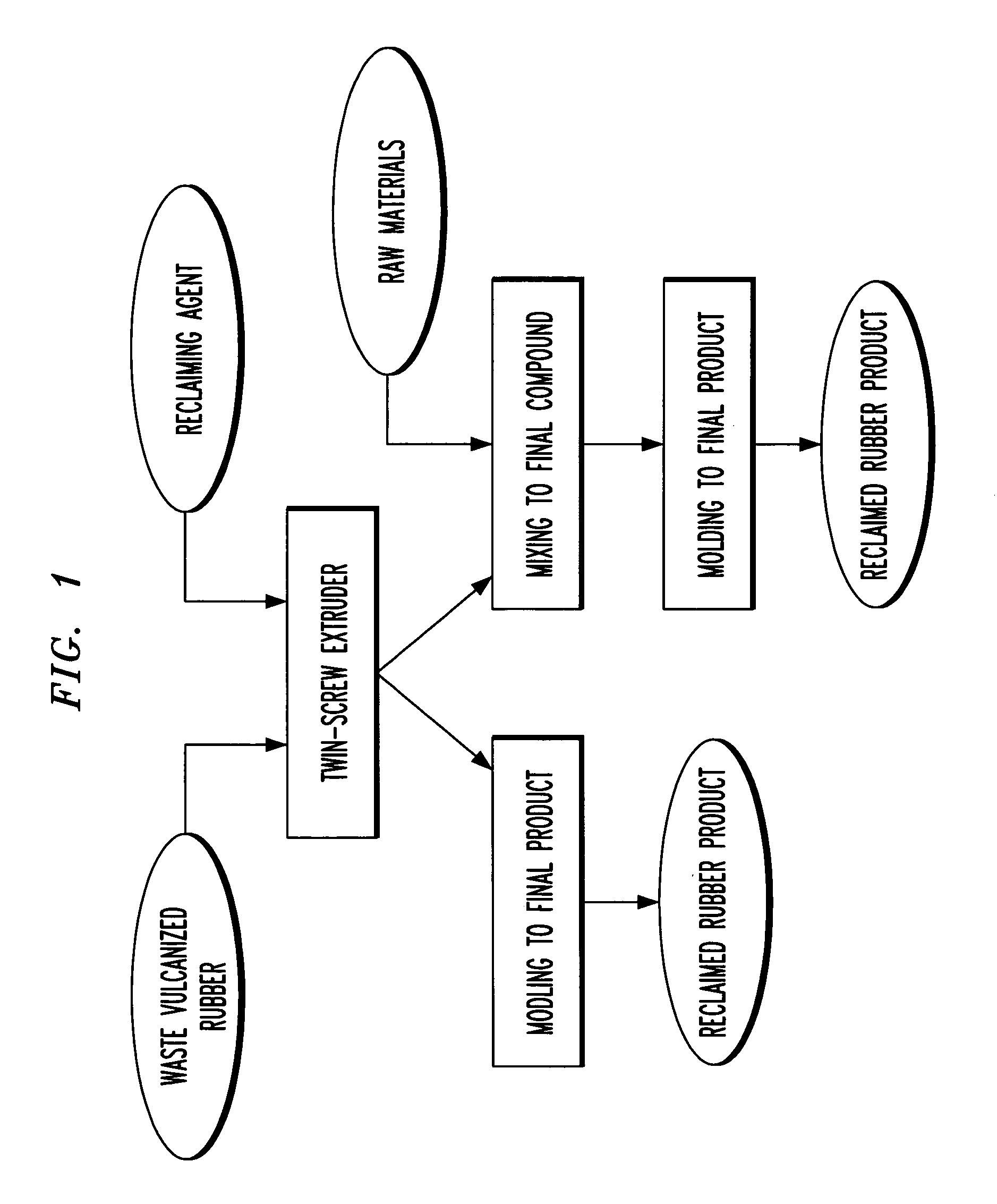Recycled rubber processing and performance enhancement
a technology of vulcanized rubber and processing equipment, applied in the field of vulcanized rubber reclaiming, can solve the problems of unable to reclaim cross-linked rubber polymer into useful products, the problem of most serious waste products, and the problem of achieving the benefits
- Summary
- Abstract
- Description
- Claims
- Application Information
AI Technical Summary
Benefits of technology
Problems solved by technology
Method used
Image
Examples
example 1
[0050]
Reclaiming agent is comprised: of the following compounds in thegiven proportions:N-tert-butyl-2-benzothiazole sulphenamide (TBBS)3Zinc salt of 2-mercaptobenzothiazole (ZMBT)8Tetramethylthiuram monosulfide (TMTM)22-mercaptobenzothiazole (MBT)4Zinc salts of fatty acids (ZS)2Zinc oxide (ZnO)1Stearic acid (SA)1Sulfur (S)2950
[0051]The compounds are mixed together, forming a powder reclaiming agent. Fine mesh rubber crumb and reclaiming agent are combined in the specialized twin-screw extruder. One part of reclaiming agent per hundred parts of rubber crumb are mixed in the extruder. Rubber crumb and reclaiming agent are masticated in the extruder for approximately one to two minutes, while a temperature between about 75.degree. C. and about 85.degree. C. is maintained, thereby devulcanizing the rubber crumb. For comparison and testing purposes, the procedure is repeated using 2 parts of reclaiming agent per hundred parts of rubber crumb to yield a second devulcanized sample.
[0052]E...
example 2
[0057]This Example demonstrates the effects of various accelerators when combined together in various ratios. TBBS, ZMBT, and TMTM are the accelerators tested. The process is similar to the process described in Example 1, except for the various accelerator combinations and ratios. The results of the tests are shown in Tables 4 and 5.
[0058]
TABLE 4Curing CharacteristicsAcceleratorAcceleratorCombinationRatioMlMhΔMTs2Tc95TBBS / ZMBT3:363.8272.348.522.004.52TBBS / ZMBT5:164.1673.048.882.245.06TBBS / TMTM5:162.2071.559.351.984.35TBBS / ZMBT1:566.8070.263.463.836.14TBBS / ZMBT / TMTM2.7 / 2.7 / 0.661.2871.3010.021.674.25TBBS / ZMBT / TMTM4.4 / 1.0 / 0.662.8873.4810.601.884.43
[0059]
TABLE 5Physical Properties when Cured at 320. degree. F. for 10 minutesModulusSpecificAcceleratorAcceleratorTensileElongationat 200%TearDuroGravityCombinationRatio(psi)(%)E (psi)(pli)(Shore A)(g / cm. sup. 3)TBBS / ZMBT3:360520060573641.17TBBS / ZMBT5:162021061078641.16TBBS / TMTM5:16102046087364.51.16TBBS / ZMBT1:560820060068641.17TBBS / ZMBT / TMTM...
example 3
[0061]This Example demonstrates the effects of testing reclaiming agent on factory scrap of nitrile rubber. Crumb from factory scrap of nitrile rubber is processed with the reclaiming agent on the extruder by the process described in examples 1 and 2. The reclaiming agent is utilized at 1.25 parts per 100 parts of crumb processed. The product is then revulcanized at 325.degree. F. for 12 minutes. The results are shown in Table 6.
[0062]
TABLE 6Physical Properties when Cured at 325. degree. F. for 12 minutesReclaimingModulusModulusAgentTensileElongationat 100%at 300%TearDuroMaterialRatio(psi)(%)(psi)(psi)(pli)(Shore A)Nitrile scrap1.25:100217036636016106465
[0063]Table 6 indicates that sulfur-cured factory scrap, regardless of type of polymer, can provide much better physical properties than post-consumer scrap by processing with the process disclosed herein. The product shows satisfactory characteristics for most commercial and industrial applications.
PUM
| Property | Measurement | Unit |
|---|---|---|
| temperature | aaaaa | aaaaa |
| temperatures | aaaaa | aaaaa |
| tensile strength | aaaaa | aaaaa |
Abstract
Description
Claims
Application Information
 Login to View More
Login to View More - R&D
- Intellectual Property
- Life Sciences
- Materials
- Tech Scout
- Unparalleled Data Quality
- Higher Quality Content
- 60% Fewer Hallucinations
Browse by: Latest US Patents, China's latest patents, Technical Efficacy Thesaurus, Application Domain, Technology Topic, Popular Technical Reports.
© 2025 PatSnap. All rights reserved.Legal|Privacy policy|Modern Slavery Act Transparency Statement|Sitemap|About US| Contact US: help@patsnap.com


